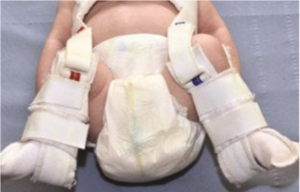Developmental Dysplasia of the Hips
A guide for parents and carers for babies born at Bedford Hospital.
Introduction
Your baby’s hips were checked at birth as part of the newborn infant physical examination (NIPE). Having had this examination, the midwife/doctor suspects that your baby may be at risk of developmental dysplasia of the hip. This leaflet gives more information about what this is and how it is diagnosed.
What is developmental dysplasia of the hip?
Developmental dysplasia of the hip (DDH) is a condition where the ball and socket joint of the hips does not form properly. It is also sometimes known as congenital hip dislocation or hip dysplasia.
The hip joint connects the thigh bone to the pelvis. The top of the thigh bone is rounded like a ball and sits inside the cupshaped hip socket.
In DDH, the socket of the hip is not well developed and the top of the thigh bone is not held tightly in place. In severe cases, the top of the thigh bone can come out of the socket (dislocate).
Without treatment, DDH may lead to problems later in life, including:
- Developing a limp
- Hip pain – especially during the teenage years
- Painful and stiff joints (osteoarthritis)
If not treated in infancy this may require major surgery later on in life.
With early diagnosis and treatment, most children are able to develop normally and have a reasonable good range of motion in their hip.
What are the risk factors for DDH?
- first-degree family history of hip problems in early life – this includes baby’s parents or siblings who have had a hip problem that started as a baby or young child that needed treatment with a splint, harness or operation.
- breech presentation at or after 36 completed weeks of pregnancy, irrespective of presentation at birth or mode of delivery; including babies who have had a successful external cephalic version (ECV).
- breech presentation at the time of birth between 28 weeks gestation and term.
How is DDH diagnosed?
In order to diagnose DDH, your baby will need to have an ultrasound scan. You will receive an appointment within 2 weeks. Your baby will need to have the hip ultrasound when they are 4-6 weeks old. It is essential for your baby to attend this appointment.
On the day of the appointment both hips are scanned by the specialist sonographer but you baby will not be routinely seen by a member of the medical team.
If you do not receive an appointment within 3 weeks please call
Bedford Hospital Radiology department: 01234 792279
If you are unable to attend the appointment, please contact Bedford Hospital radiology department 01234 792279.
We will discuss the results of the scan with you. If DDH is diagnosed, referral to orthopaedics will be made by the ultrasound team and the orthopaedic team will discuss treatment plans at the following appointment with them.
How is DDH treated? 
Babies diagnosed with DDH early in life are usually treated with a fabric splint called a Pavlik harness (see picture below). This secures both of your baby’s hips in a stable position and allows them to develop normally. The harness needs to be worn constantly for several weeks and should not be removed by anyone except a health professional.
We will provide detailed instructions on how to look after your baby while they are wearing a Pavlik harness.
A semi rigid brace or surgery is required if the Pavlik harness has not helped.
Further information
Screening tests for you and your baby
www.gov.uk/government/publications/screeningtests-foryou-and-your-baby
